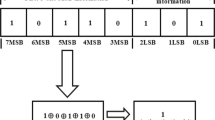Abstract
Statistical fragile watermarking is capable of accurately locating tampered pixels and resisting the collage attack. However, the constraint of the tamper ratio may be too stringent. This paper proposes a neighborhood characteristic based detection model for statistical fragile watermarking to lift the constraints of the tampered area from 4% to 14% of the host image. The neighborhood characteristic is used to effectively decrease the probability of false rejection, while the low probability of false acceptance is guaranteed by selecting proper threshold. The tamper detection performance of the proposed detection model is analytical analyzed in the different conditions. Analytical and experimental results demonstrate that the neighborhood characteristic based detection model effectively reduce the total number of false decisions and detect the tampered pixels with high probability.









Similar content being viewed by others
References
Barreto P, Kim H, Rijmen V (2002) Toward secure public-key block-wise fragile authentication watermarking. IEEE Proc Vis Image Signal Process 149:57–62
Celik M, Sharma G, Saber E, Tekalp AM (2002) Hierarchical watermarking for secure image authentication with localization. IEEE Trans Image Process 11(6):585–595
Deguillaume F, Voloshynovskiy S, Pun T (2003) Secure hybrid robust watermarking resistant against tampering and copy attack. Signal Process 83:2133-2170
Fridrich J (2002) Security of fragile authentication watermarks with localization. Proc SPIE 4675:691–700
Fridrich J, Goljan M, Memon N (2002) Cryptanalysis of the Yeung–Mintzer fragile watermarking technique. Electron Imag 11:262–274
He H, Zhang J, Tai H-M (2006) A wavelet-based fragile watermarking scheme for secure image authentication. In: Proc 5th int workshop digital watermarking. Lecture Notes in Computer Science, vol 4283, pp 422–432
He H, Zhang J, Chen F (2007) Block-wise fragile watermarking scheme based on scramble encryption. In: Proc int conf bio-inspired computing: theories and applications in Sept, pp 216–220
He H-J, Zhang J-S, Chen F (2009) Adjacent-block based statistical detection method for self-embedding watermarking techniques. Signal Process 89:1557–1566
He H, Zhang J, Tai H-M (2009) Self-recovery fragile watermarking using block-neighborhood tampering characterization. In: 11th Int workshop, IH 2009. Darmstadt, Germany, 7–10 June
Ho ATS, Zhu X, Shen J, Marziliano P (2008) Fragile watermarking based on encoding of the zeroes of the z-Transform. IEEE Trans Inf Forensics Security 3(3):567–569
Holliman H, Memon N (2000) Counterfeiting attacks on oblivious block-wise independent invisible watermarking schemes. IEEE Trans Image Process 9(3):432–441
Lee T-Y, Lin SD (2008) Dual watermark for image tamper detection and recovery. Pattern Recogn 41:3497–3506
Lee S, Yoo CD, Kalker T (2007) Reversible image watermarking based on integer-to-integer wavelet transform. IEEE Trans Inf Forensics Security 2(3):321–330
Liu S-H, Yao H-X, Gao W, Liu Y-L (2007) An image fragile watermark scheme based on chaotic image pattern and pixel-pairs. Appl Math Comput 185(2):869–882
Ohkita K, Yoshida M, Kitamura I, Fujiwara T (2009) Improving capability of locating tampered pixels of statistical fragile watermarking, IWDW 2009, LNCS 5703, pp 279–293
Suthaharan S (2004) Fragile image watermarking using a gradient image for improved localization and security. Pattern Recogn Lett 25:1893–1903
Wang M, Chen W (2007) A majority-voting based watermarking scheme for color image tamper detection and recovery. Comput Stand Interfaces 29(5):561–570
Wong P (1998) A public key watermark for image verification and authentication. In: Proc IEEE int conf image processing, Chicago, pp 425–429
Wong P, Memon N (2001) Secret and public key image watermarking schemes for image authentication and ownership verification. IEEE Trans Image Process 10:1593–1601
Wu J, Zhu B, Li S, Lin S (2004) A secure image authentication algorithm with pixel-level tampering localization. In: Proceedings of the IEEE international conference on image processing (ICIP’04), Singapore
Yeung M, Mintzer F (1997) An invisible watermarking technique for image verification. In: Proc int conf image processing, vol 1, pp 680–683
Zhang X, Wang S (2007) Statistical fragile watermarking capable of locating individual tampered pixels. IEEE Signal Process Lett 14(10):727–731
Zhang X, Wang S (2009) Fragile watermarking scheme using a hierarchical mechanism. Signal Process 89(4):675–679
Acknowledgements
This work is supported in part by the National Natural Science Foundation of China (Grant No. 60970122, 60772084, 60702025), the National S & T Major Project of China (Grant No.2008ZX05046-01), and by the Research Fund for the Doctoral Program of Higher Education (Grant No. 20090184120021, 20070613024)
Author information
Authors and Affiliations
Corresponding author
Rights and permissions
About this article
Cite this article
He, H., Zhang, J. & Tai, HM. A neighborhood-characteristic-based detection model for statistical fragile watermarking with localization. Multimed Tools Appl 52, 307–324 (2011). https://doi.org/10.1007/s11042-010-0474-6
Published:
Issue Date:
DOI: https://doi.org/10.1007/s11042-010-0474-6




